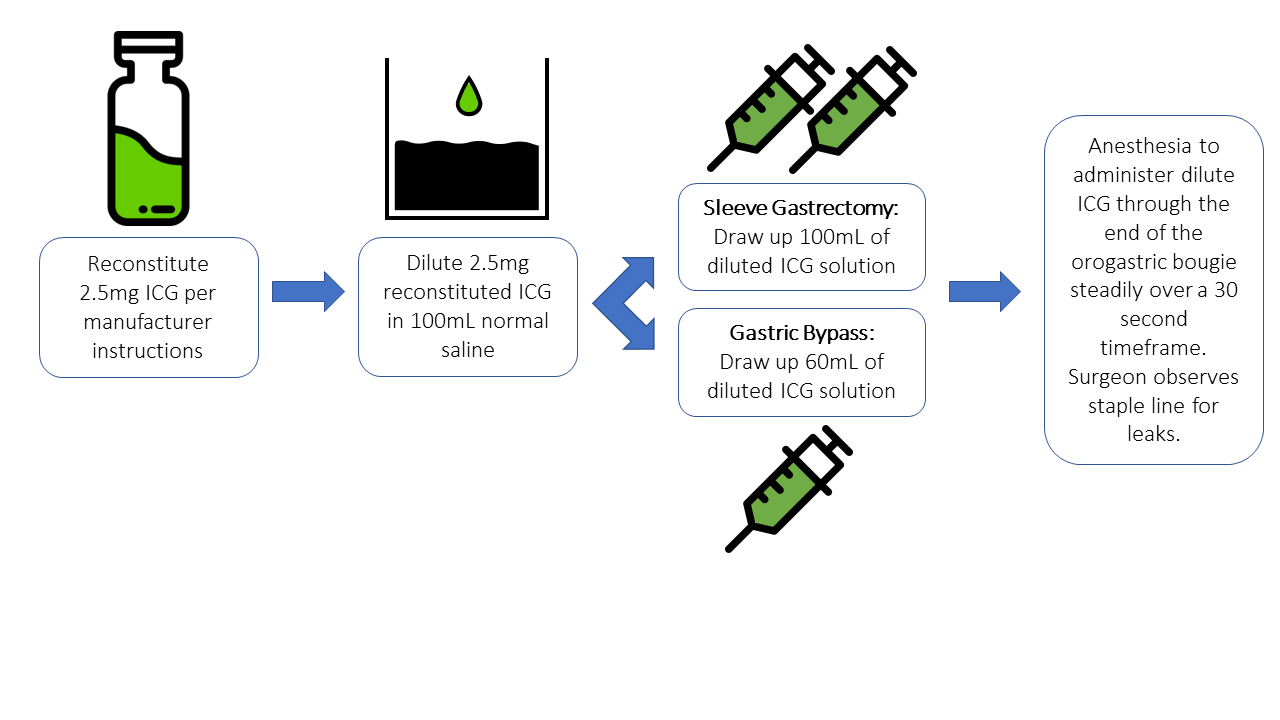As bariatric procedure numbers continue to grow, the need for standardization becomes increasingly important for patient safety and physician protection. [1] Since its incorporation into medical practice by I.J Fox in 1957, indocyanine green (ICG) has been used in various applications to determine liver function, identify cardiac murmurs, evaluate brain perfusion, diagnose ophthalmic perfusion, and confirm hepatobiliary anatomy. [2] [3] [4] [5] [6]
For bariatric applications, ICG is a valuable tool to identify staple line leaks under near infrared (NIR) visualization. [7] Staple line leakage following bariatric surgery has always been a complication that leads to increased healthcare cost and additional recovery time. By identifying these leaks intraoperatively, physicians can diminish the likelihood that a patient will encounter complications with sepsis, multisystem organ failure, enterocutaneous fistulas, prolonged hospital stays, and death. [8] [9]
Kalmar et al. characterize the administration of intraluminal ICG through an orogastric tube directly to the staple line to identify any leakage of ICG under direct visualization with NIR imaging (Figure 1). The advantage of this technique is the localized visualization of the leak as well as the return to normal visualization once standard light is resumed (Figure 2). Unlike methylene blue, ICG does not stain the tissue and thus any repairs to leaking staple lines may be conducted on visually native tissue.
ICG is reconstituted per manufacturer instructions and then diluted in 100mL sterile saline (2.5mg/100mL). The diluted ICG is then administered through a previously placed orogastric sizing tube with an injectable port and the proprietary exit holes deliver the ICG directly to the staple line. The anesthesiologist administers 100mL of dilute ICG for sleeve gastrectomy or 60mL of dilute ICG for gastric bypass. Visualization during administration allows for the real time detection of staple line leakage, increasing the safety and efficacy of stapling during sleeve gastrectomy.
Instructions for Administering ICG for leak tests using an orogastric bougie.

Figure 1. Demonstration of fluorescent extravasation of ICG at a punctate defect along the gastric staple line visualized under NIR. [9]
Figure 2. View of the operative field immediately after disengaging laser.
References
| [1] | A. A. Alawan, J. Friedman, H. Park, R. Segal, B. A. Brumback and A. G. Hartzema, “US national trends in bariatric surgery: A decade of study,” Surgery, vol. 170, no. 1, pp. 13-17, 2021. |
| [2] | I. J. Fox and E. H. Wood, “Indocyanine green: physical and physiologic properties,” in Proceedings of the staff meetings of the Mayo Clinic, 1960. |
| [3] | J. G. Walker, H. Silva, T. R. Lawson, J. A. Ryder and S. Shaldon, “Renal blood flow in acute renal failure measured by renal arterial infusion of indocyanine green,” Experimental Biology and Medicine, vol. 11, pp. 932-5, 1963. |
| [4] | A. Wennevold and I. H. Rygg, “The interpretation of intracardiac phonocardiography of a continuous murmur developed after radical operation for tetralogy of Fallot,” Scandinavian Journal of Thoracic and Cardiovascular Surgery, vol. 2, no. 2, pp. 96-8, 1968. |
| [5] | T. A. Huffman, R. S. Goodwin, R. F. Leighton, J. M. Ryan and C. F. Wooley, “Intracarduac phonocardiography in the differential diagnosis of continuous murmus,” Annals of Internal Medicine, vol. 63, pp. 904-5, 1965. |
| [6] | K. Kogure and E. Choromokos, “Infrared absorption angiography,” Journal of Applied Physiology, vol. 26, pp. 154-7, 1969. |
| [7] | C.-H. Lu and J.-K. Hsiao, “Indocyanine green: An old drug with novel applications,” Tzu Chi Medical Journal, vol. 33, no. 4, pp. 317-322, 2021. |
| [8] | R. Gonzalez, M. G. Sarr, M. Baghai, M. Kendrick, S. Szomstein, R. Rosenthal and M. M. Murr, “Diagnosis and contemporary management of anastomotic leaks after gastric bypass for obesity,” American College of Surgeons, vol. 204, no. 1, pp. 47-55, 2007. |
| [9] | C. L. Kalmar, C. M. Reed, C. L. Peery and A. D. Salzberg, “Intraluminal indocyanine green for intraoperative staple line leak testing in bariatric surgery,” Surgical Endoscopy, vol. 34, pp. 4194-4199, 2020. |
| [10] | J. Bingham, M. Lallemand, M. Barron, J. Kuckleman, P. Carter, K. Blair and M. Martin, “Routine intraoperative leak testing for sleeve gastrectomy: is the leak test full of hot air?,” American Journal of Surgery, vol. 211, no. 5, pp. 1592-1596, 2-16. |
| [11] | G. C. Kirby, C. W. Macano, S. M. Nyasavajjala, M. Sahloul, R. Nijjar, M. Daskalakis, M. Richardson and R. Singhal, “The Birmingham experience of high-pressure methylene blue dye test during primary and revisional bariatric surgery: A retrospective cohort study,” Annals of Medicine and Surgery, vol. 23, pp. 32-34, 2017. |
Back to Blog




